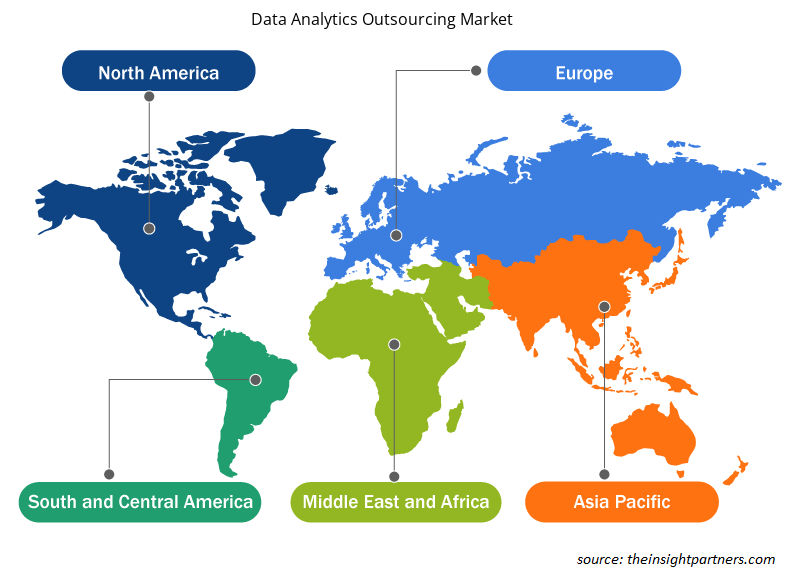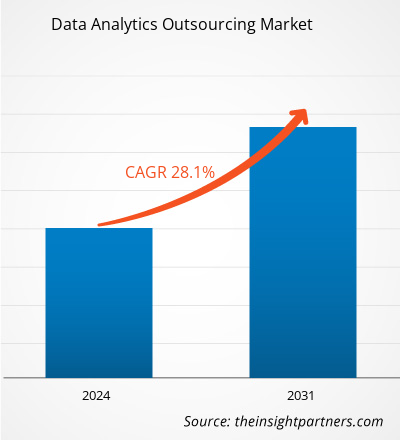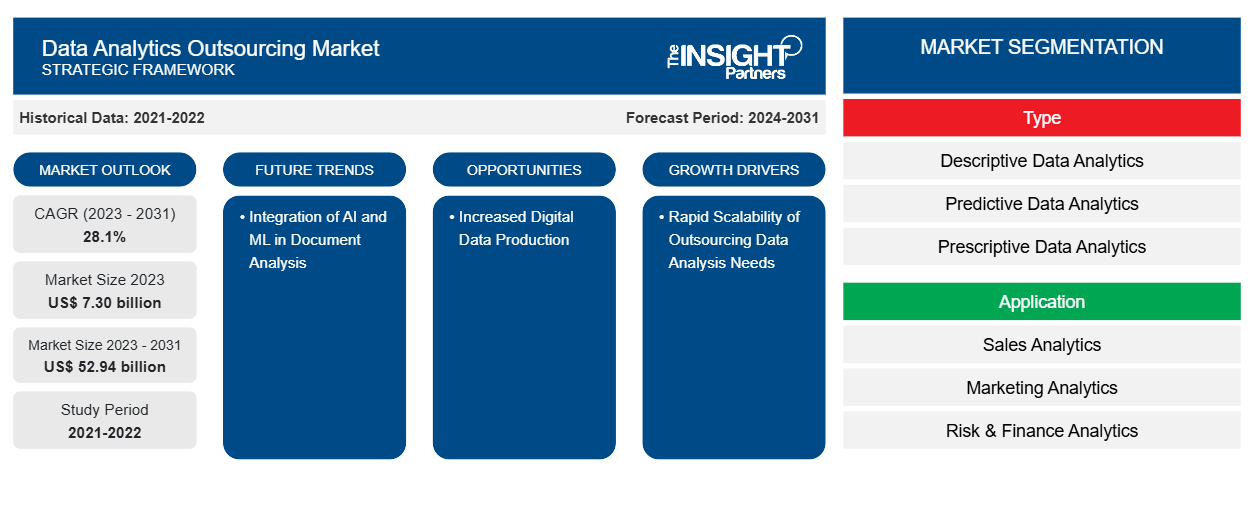Si prevede che la dimensione del mercato dell'outsourcing dell'analisi dei dati raggiungerà i 52,94 miliardi di dollari entro il 2031, rispetto ai 7,30 miliardi di dollari del 2023. Si prevede che il mercato dell'outsourcing dell'analisi dei dati registrerà un CAGR del 28,1% nel 2023-2031. L'outsourcing dell'analisi dei dati è una strategia collaborativa in cui un'azienda affida i propri dati a un fornitore di servizi e riceve informazioni intelligenti.
Analisi di mercato dell'outsourcing dell'analisi dei dati
L'intelligenza artificiale (IA) ha sostituito gli esseri umani in molti elementi dell'analisi dei dati, richiedendo meno lavoro manuale. Di conseguenza, la natura dell'outsourcing dell'analisi dei dati si concentra su come gli esseri umani possono progettare e addestrare in modo efficiente un modello ML piuttosto che gestire uno staff offshore. La produzione di dati su larga scala ha incoraggiato le organizzazioni a cercare approfondimenti sulla segmentazione dei consumatori, sulla comprensione delle preferenze all'interno di ciascuna categoria, sul rimanere aggiornati sui cambiamenti comportamentali e sulla personalizzazione. Grazie al maggiore utilizzo di Internet, le aziende hanno ora accesso a un'enorme quantità di dati organizzati e non strutturati.
Panoramica del mercato dell'outsourcing dell'analisi dei dati
L'outsourcing dell'analisi dei dati è una strategia collaborativa in cui un'azienda affida i propri dati a un fornitore di servizi e riceve informazioni intelligenti. Allo stesso tempo, il fornitore gestisce tutto il resto, tra cui la configurazione e il supporto dell'infrastruttura, la gestione dei dati e l'analisi. L'outsourcing dell'analisi dei dati a fornitori di servizi esperti migliora l'accuratezza dell'elaborazione dei dati, semplifica le procedure correlate e fornisce informazioni di qualità superiore per un processo decisionale informato. Inoltre, le aziende di outsourcing dell'analisi dei dati utilizzano strumenti e tecnologie all'avanguardia che vengono costantemente aggiornati per offrire i migliori risultati possibili ai propri clienti. Nel settore bancario, l'analisi dei dati può essere utilizzata per una varietà di scopi, che vanno dal miglioramento della sicurezza informatica alla riduzione al minimo dell'abbandono dei clienti. Le banche possono ricevere e utilizzare dati aggiuntivi da fonti esterne, come il coinvolgimento commerciale, normativo e sui social media, una volta elaborati e analizzati.
Personalizza questo report in base alle tue esigenze
Riceverai la personalizzazione gratuita di qualsiasi report, comprese parti di questo report, o analisi a livello nazionale, pacchetto dati Excel, oltre a usufruire di grandi offerte e sconti per start-up e università
-
Scopri le principali tendenze di mercato in questo rapporto.Questo campione GRATUITO includerà analisi di dati che spaziano dalle tendenze di mercato alle stime e alle previsioni.
Driver e opportunità di mercato dell'outsourcing dell'analisi dei dati
Aumento della produzione di dati digitali per favorire il mercato
L'era della digitalizzazione ha portato a una maggiore generazione di dati digitali globali. L'uso diffuso di dispositivi digitali, come smartphone e computer, ha portato a un'impennata nella spesa per i dati digitali. La crescente popolarità dell'Internet of Things (IoT) e dei dati raccolti dai suoi dispositivi stanno contribuendo a questa impennata. Gli analisti di dati hanno difficoltà a elaborare e interpretare enormi quantità di dati digitali. Le aziende stanno sempre più esternalizzando soluzioni di analisi dei dati a causa degli elevati costi e degli investimenti iniziali associati alle soluzioni interne. I servizi di esternalizzazione possono aiutare le organizzazioni a stabilire rapidamente framework analitici, che altrimenti potrebbero essere difficili o richiedere molto tempo.
Rapida scalabilità delle esigenze di analisi dei dati in outsourcing
I servizi di outsourcing possono anche aiutare le organizzazioni a sviluppare rapidamente un framework di analisi, che altrimenti sarebbe difficile, se non impossibile, e costoso da eseguire con le capacità interne di una piccola o media impresa. Inoltre, sfruttare la tecnologia e le risorse del fornitore esternalizzato per migliorare l'efficienza operativa degli strumenti e dei processi di analisi dei dati, come l'implementazione di un data center avanzato, l'automazione dei processi robotici o il software basato su cloud, può essere un vantaggio significativo. Secondo AMR, l'outsourcing dell'analisi dei dati a un partner terzo può anche aiutare un'azienda a utilizzare soluzioni più creative che potrebbe non aver esplorato in precedenza. Le piccole e medie imprese potrebbero non essere in grado di impiegare tale competenza internamente.
Analisi della segmentazione del rapporto di mercato dell'outsourcing dell'analisi dei dati
I segmenti chiave che hanno contribuito alla derivazione dell'analisi di mercato dell'outsourcing dell'analisi dei dati sono tipologia, applicazione e utente finale.
- In base alla tipologia, il mercato dell'outsourcing dell'analisi dei dati è suddiviso in analisi dei dati descrittiva, analisi dei dati predittiva e analisi dei dati prescrittiva.
- In base all'applicazione, il mercato è segmentato in analisi delle vendite , analisi di marketing, analisi del rischio e della finanza e analisi della supply chain.
- In base all'utente finale, il mercato dell'outsourcing dell'analisi dei dati è segmentato in BFSI, sanità, vendita al dettaglio, produzione, telecomunicazioni e media e intrattenimento.
Analisi della quota di mercato dell'outsourcing dell'analisi dei dati per area geografica
L'ambito geografico del report di mercato dell'outsourcing dell'analisi dei dati è principalmente suddiviso in cinque regioni: Nord America, Asia Pacifico, Europa, Medio Oriente e Africa e Sud America/Sud e Centro America. I crescenti dati sulla penetrazione sociale hanno modelli nascosti che gli strumenti di analisi standard non riescono a rilevare. Secondo We Are Social, la penetrazione attiva dei social network in Cina e negli Stati Uniti lo scorso anno è stata rispettivamente del 64,6% e del 72,3%, indicando un elevato volume di generazione di dati che richiede analisi. Ciò incoraggia le aziende in tutto il paese a esternalizzare l'analisi dei dati.
Approfondimenti regionali sul mercato dell'outsourcing dell'analisi dei dati
Le tendenze regionali e i fattori che influenzano il mercato dell'outsourcing di analisi dei dati durante il periodo di previsione sono stati ampiamente spiegati dagli analisti di Insight Partners. Questa sezione discute anche i segmenti e la geografia del mercato dell'outsourcing di analisi dei dati in Nord America, Europa, Asia Pacifico, Medio Oriente e Africa e America meridionale e centrale.

- Ottieni i dati specifici regionali per il mercato dell'outsourcing dell'analisi dei dati
Ambito del rapporto di mercato sull'outsourcing dell'analisi dei dati
| Attributo del report | Dettagli |
|---|---|
| Dimensioni del mercato nel 2023 | 7,30 miliardi di dollari USA |
| Dimensioni del mercato entro il 2031 | 52,94 miliardi di dollari USA |
| CAGR globale (2023-2031) | 28,1% |
| Dati storici | 2021-2022 |
| Periodo di previsione | 2024-2031 |
| Segmenti coperti |
Per tipo
|
| Regioni e Paesi coperti |
America del Nord
|
| Leader di mercato e profili aziendali chiave |
|
Densità degli attori del mercato dell'outsourcing dell'analisi dei dati: comprendere il suo impatto sulle dinamiche aziendali
Il mercato dell'outsourcing dell'analisi dei dati sta crescendo rapidamente, spinto dalla crescente domanda degli utenti finali dovuta a fattori quali l'evoluzione delle preferenze dei consumatori, i progressi tecnologici e una maggiore consapevolezza dei vantaggi del prodotto. Con l'aumento della domanda, le aziende stanno ampliando le loro offerte, innovando per soddisfare le esigenze dei consumatori e capitalizzando sulle tendenze emergenti, il che alimenta ulteriormente la crescita del mercato.
La densità degli operatori di mercato si riferisce alla distribuzione di aziende o società che operano in un particolare mercato o settore. Indica quanti concorrenti (operatori di mercato) sono presenti in un dato spazio di mercato in relazione alle sue dimensioni o al valore di mercato totale.
Le principali aziende che operano nel mercato dell'outsourcing dell'analisi dei dati sono:
- Accentura
- Capgemini Italia
- Analisi frattale Inc.
- Genpact
- Informazioni limitate
- Mu Sigma Inc.
Disclaimer : le aziende elencate sopra non sono classificate secondo un ordine particolare.

- Ottieni una panoramica dei principali attori del mercato dell'outsourcing dell'analisi dei dati
Notizie e sviluppi recenti sul mercato dell'outsourcing dell'analisi dei dati
Il mercato dell'outsourcing dell'analisi dei dati viene valutato raccogliendo dati qualitativi e quantitativi dopo la ricerca primaria e secondaria, che include importanti pubblicazioni aziendali, dati associativi e database. Di seguito è riportato un elenco degli sviluppi nel mercato:
- A giugno 2023, Genpact ha annunciato una collaborazione con Google Cloud per aiutare le aziende ad accelerare le strategie di intelligenza artificiale (IA), tra cui lo sfruttamento dell'adozione dell'IA generativa per ottenere informazioni aziendali fruibili.
(Fonte: Genpact, Comunicato stampa, 2023)
- A settembre 2023, IBM ha annunciato i piani per introdurre nuovi modelli generativi basati sull'intelligenza artificiale e aggiornamenti a Watsonx. Queste aggiunte includono un'anteprima tecnica di Watsonx. Watsonx offrirà presto governance e nuove offerte di dati AI avanzati. Dati e l'integrazione pianificata dei modelli di fondazione Watsonx.ai in prodotti software e infrastrutturali selezionati.
(Fonte: IBM, Comunicato stampa, 2023)
Copertura e risultati del rapporto di mercato sull'outsourcing dell'analisi dei dati
Il rapporto "Dimensioni e previsioni del mercato dell'outsourcing dell'analisi dei dati (2021-2031)" fornisce un'analisi dettagliata del mercato che copre le seguenti aree:
- Dimensioni e previsioni del mercato a livello globale, regionale e nazionale per tutti i segmenti di mercato chiave coperti dall'ambito
- Dinamiche di mercato come fattori trainanti, vincoli e opportunità chiave
- Principali tendenze future
- Analisi dettagliata delle cinque forze PEST/Porter e SWOT
- Analisi di mercato globale e regionale che copre le principali tendenze di mercato, i principali attori, le normative e gli sviluppi recenti del mercato
- Analisi del panorama industriale e della concorrenza che copre la concentrazione del mercato, l'analisi della mappa di calore, i principali attori e gli sviluppi recenti
- Profili aziendali dettagliati
- Analisi storica (2 anni), anno base, previsione (7 anni) con CAGR
- Analisi PEST e SWOT
- Valore/volume delle dimensioni del mercato - Globale, Regionale, Nazionale
- Industria e panorama competitivo
- Set di dati Excel
Report recenti
Rapporti correlati
Testimonianze
Motivo dell'acquisto
- Processo decisionale informato
- Comprensione delle dinamiche di mercato
- Analisi competitiva
- Analisi dei clienti
- Previsioni di mercato
- Mitigazione del rischio
- Pianificazione strategica
- Giustificazione degli investimenti
- Identificazione dei mercati emergenti
- Miglioramento delle strategie di marketing
- Aumento dell'efficienza operativa
- Allineamento alle tendenze normative























 Ottieni un campione gratuito per - Mercato dell'outsourcing dell'analisi dei dati
Ottieni un campione gratuito per - Mercato dell'outsourcing dell'analisi dei dati